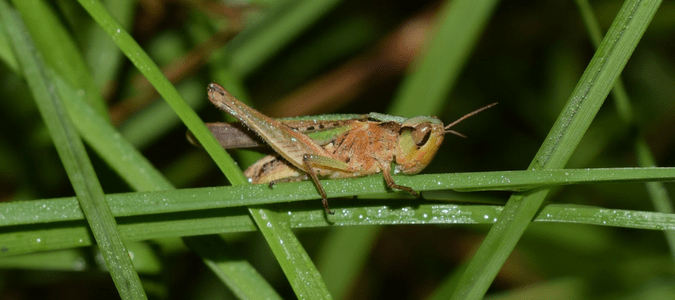
There’s no doubt about it: Many insects look alike. That’s even truer when the two insects in question belong to the same family. Take crickets and grasshoppers, for example. There’s been much discussion about grasshoppers vs. crickets, so let’s discuss some differences between the two species.
Grasshoppers vs Crickets: What’s the Difference?
At first glance, the two insects look very similar. Their bodies are similarly structured, and they both have antennas. That said, you can tell these hopping creatures apart in several ways.
Family Ties
Both the cricket and the grasshopper belong to the Orthoptera order. Another member of this family is the locust. While crickets and grasshoppers share a common ancestry, they belong to different suborders. Grasshoppers belong to the Caeliferans suborder, while crickets belong to the Ensifera suborder. There are more species of grasshoppers—11,000—compared to the number of cricket species: over 900.
Distinguishing Characteristics
Though the two look very similar at first glance, a closer look will reveal several differences in each insect’s physical characteristics. For starters, grasshoppers are much more giant than crickets. While a grasshopper can measure four inches in length, the largest a cricket can grow is two inches. Their antennae can also help distinguish the two insects. Crickets have a pair of very long antennae located on the top of their heads. Grasshoppers, on the other hand, have a couple of very short antennae. Essentially, the one with a more petite body has longer antennae and vice versa.
Another difference is their color. Grasshoppers tend to be bright green, which enables them to blend and camouflage into their surrounding environment. Crickets, on the other hand, are usually pale green or brown. Crickets are nocturnal, so the darker color helps protect the animals from predators.
Finally, most crickets are wingless and move around by jumping. You usually find out a grasshopper is hiding in a patch of grass because when you get close to them, they are able to jump, hop or fly.
Habitat, Diet and Songs
While crickets are nocturnal, grasshoppers are active during the day. Their diet is also quite different. Grasshoppers are herbivores that feed on various types of grass. Crickets are omnivores and eat various types of plants, insect eggs, larvae, other insects and aphids.
Despite these differences, these insects prefer similar habitats. Both grasshoppers and crickets prefer warmer weather and temperatures. Although these bugs live in similar places, they produce sounds differently. The cricket rubs its wings together to make its characteristic chirping noise, which serves to attract mates and is also referred to as “stridulating”. The sound is produced by rubbing the top of one wing along the teeth on the bottom side of the second wing. Only male crickets create these songs, and the warmer it is, the more the crickets will sing. Most grasshopper species do not make sounds, and those that do create sounds may be difficult to hear. Both male and female grasshoppers produce these soft and muffled sounds by rubbing their hind legs with their wings. Band-winged grasshoppers pop the membranes between their veins to create a snapping sound, which is also relatively quiet.
How to Keep Grasshoppers and Crickets Away
Grasshoppers do feed on the plants in your lawn, so you may want to deter them from hanging around among your plants. You may also want to prevent crickets from congregating on your porch or patio, since they are attracted to light and can easily hope inside. One way to keep crickets and grasshoppers off your property is to plant flowers that will attract birds that prey on them. You can also try creating a small patch of long grass in one area of your yard, since long grass provides a haven for grasshoppers and crickets. Attracting these bugs to one area of your lawn could help you contain them. Here are some additional tips on how to get rid of them on your own:
- Use natural repellents. By mixing crushed garlic with some water, you could deter grasshoppers by creating a simple deterring spray, as they don’t like the taste or smell.
- Dust plants with all-purpose flour. Flour doesn’t harm your plants and creates a barrier which makes it harder for a grasshopper to feed on your grass.
- Introduce beneficial insects. Spiders, preying mantis, beetles and even lizards are all predators of crickets and grasshoppers. Before spraying insecticide, consider attracting these beneficial creatures around.
- Remove bright lights. Crickets are attracted to bright lights, so if you have a well-lit entryway, you may be attracting them to your door. Consider switching to lower “bug lights” or amber LED lights.
- Cut your grass regularly. Both crickets and grasshoppers thrive in long grass. To prevent them from building their nests, make sure your lawn is maintained on a consistent basis.
ABC Can Help You With Lawn Pests
Grasshoppers and crickets might not be causing much damage to your lawn, but other pests might be keeping your outdoor spaces from looking as beautiful as you’d like them to be. Our team at ABC Home & Commercial Services can help you at any time, with any kind of pests—indoors and outside. Our team of experts can effectively assess the situation at hand and properly determine the best way to remove whatever critters might be bugging you. We’ll keep your home and yard pest free today and tomorrow.